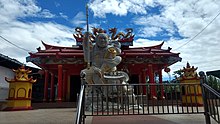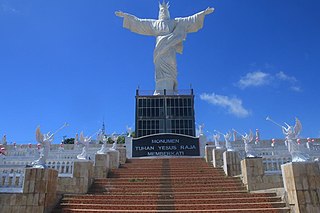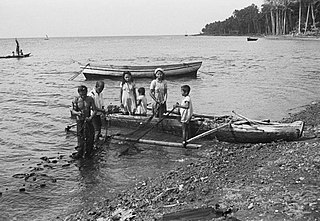North Sulawesi Sulawesi Utara | |
|---|---|
| Province of North Sulawesi | |
| Motto(s): Si Tou Timou Tumou Tou(Minahasan) Men live to help other's life | |
 Location of North Sulawesi in Indonesia | |
| Coordinates: 1°15′N124°50′E / 1.250°N 124.833°E | |
| Established | 14 August 1959 |
| Founded by | Sam Ratulangi |
| Capital and largest city | Manado |
| Government | |
| • Body | North Sulawesi Provincial Government |
| • Governor | Olly Dondokambey |
| • Vice Governor | Steven Kandouw |
| Area | |
| • Total | 13,892.74 km2 (5,364.02 sq mi) |
| • Rank | 32nd in Indonesia |
| Highest elevation | 1,995 m (6,545 ft) |
| Population (mid 2023 estimate) [1] | |
| • Total | 2,681,540 |
| • Density | 190/km2 (500/sq mi) |
| Demographics | |
| • Ethnic groups | 43% Minahasan 23% Sangirese (and Talaud) 17% Mongondow 7.5% Gorontaloan 3.2% Chinese 6.3% other |
| • Religion | 67.4% Christianity -63% Protestant -4.4% Catholic 31.8% Islam 0.8% other |
| • Languages | Indonesian (official) Manado Malay (lingua franca) Minahasan languages (Tontemboan, Tombulu, Tonsea, Toulour and Tonsawang), Mongondow, Sangirese, Talaud, Bantik, Ratahan, Ponosakan, Bintauna (regional) |
| Time zone | UTC+8 (Indonesia Central Time) |
| ISO 3166 code | ID-SA |
| GDP (nominal) | 2022 |
| - Total [2] | Rp 157.0 trillion (24th) US$ 10.6 billion Int$ 33.0 billion (PPP) |
| - Per capita [3] | Rp 59.0 million (18th) US$ 3,976 Int$ 12,408 (PPP) |
| - Growth [4] | |
| HDI | |
| Website | sulutprov.go.id |
North Sulawesi (Indonesian : Sulawesi Utara) is a province of Indonesia. It is mainly located on the Minahasa Peninsula of the island of Sulawesi, south of the Philippines and southeast of Sabah, Malaysia, but also includes various small archipelagoes situated between the Minahasa Peninsula and the southern Philippines. It borders the Philippine province of Davao Occidental and Soccsksargen regions of the Philippines to the north, the Maluku Sea to the east, Gorontalo and Celebes Sea to the west and the Gulf of Tomini to the southwest. The province's furthest extent, the outlying and isolated island of Miangas to its north, is the northernmost island of Indonesia.
Contents
- Etymology
- History
- Pre-Colonial Era
- Colonial Period
- Independence
- Environment
- Climate
- Geography
- Flora and Fauna
- Demographics
- Religion
- Ethnicity
- Language
- Administrative divisions
- References
- External links
The province's area is 14,500.28 square kilometres (5,598.59 sq mi), and its population was 2,270,596 according to the 2010 census; [5] this rose to 2,621,923 at the 2020 Census, [6] while the official estimate as at mid 2023 was 2,681,540 (comprising 1,369,850 males and 1,311,690 females). [1] North Sulawesi is known as a heaven for divers around the world.
The province's capital and largest city is Manado, which is also the main gateway and the economic center of the province. Other major towns includes Tomohon and Bitung in the northern (Minahasa) half of the province, and Kotamobagu in the southern (Bolaang Mongondow) half. There are 41 mountains with an altitude ranging from 1,112–1,995 metres (3,648–6,545 ft). Most geologic conditions in the province are consisted mainly of young volcanic regions, with numerous eruptions and many active volcanic cones that adorn the central Minahasa, Bolaang Mongondow and Sangihe Islands.
North Sulawesi in the past was an area of potential spices, rice and gold which became a battleground for the interests of economic hegemony between the Portuguese, Spanish, Dutch and the Kingdoms around this area, which ultimately led to political and military struggles. The past of this region also became the trading route between west and east and the spread of Christianity, Islam and belief or religion brought by Chinese merchants. The Portuguese first landed on the area at the 16th century. Following decades of war between the Portuguese, the Spanish and the Dutch to control the area, the area ultimately fell to the Dutch at the 17th century. The Dutch ruled the area for three centuries, before being ousted by the Japanese on the eve of World War II. Following the Japanese surrender in 1945, the Dutch briefly regained possession of the area, before finally leaving in 1949 following the Round Table Conference, in which the Dutch recognized the newly created United States of Indonesia (RIS). Thus, North Sulawesi was incorporated into the territory of the State of East Indonesia (NIT). The NIT was finally dissolved and then merged into the RIS.
On 17 August 1950, the RIS was officially disbanded and then re-formed as the unitary state of the Republic of Indonesia. The island of Sulawesi was governed briefly as a single province, before being separated into several different provinces. Thus, the province of North Sulawesi was created on 14 August 1959. The western half of this area (as that time comprising the Gorontalo Regency and the newly created Boalemo Regency) was separated from North Sulawesi on 5 December 2000 and established as the province of Gorontalo.



















